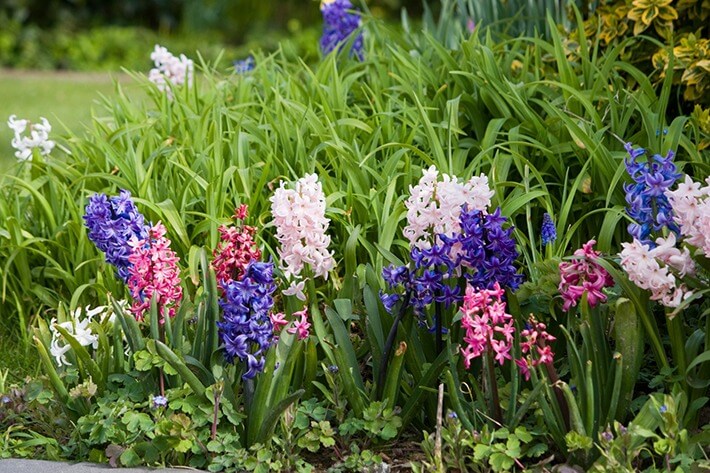Planting Hyacinth Bulbs: Your Guide To Stunning Spring Flowers

Table of Contents
Choosing the Right Hyacinth Bulbs
Selecting the right hyacinth bulbs is the first step to a successful spring bloom. Several hyacinth bulb varieties offer a stunning range of colors and fragrances. Popular choices include the classic Delft Blue, the delicate Pink Pearl, and the pure White Pearl. However, many other exciting hyacinth bulb varieties are available, allowing you to create a personalized spring display.
When choosing your hyacinth bulbs, remember that quality matters. Look for firm, healthy bulbs free from any signs of mold, damage, or soft spots. Larger hyacinth bulbs generally produce larger and more robust blooms, so consider bulb size when making your selections.
- Inspect bulbs for firmness and lack of mold or damage. Discard any bulbs that show signs of decay.
- Consider the color and fragrance preferences when selecting varieties. The range of colors and scents available is vast!
- Purchase bulbs from reputable suppliers to ensure quality. This will significantly increase your chances of successful planting.
Preparing for Planting Hyacinth Bulbs
Timing is crucial when planting hyacinth bulbs. The ideal planting time is usually in the fall, typically between September and November, before the ground freezes. This allows the bulbs time to establish their root system before winter. Proper soil preparation is equally important for healthy growth. Hyacinths thrive in well-drained, loose soil. Amending heavy clay soils with compost or peat moss improves drainage and provides essential nutrients.
When planting, ensure the soil is well-prepared. You'll want to dig holes approximately 6 inches deep and 6-8 inches apart to allow for adequate spacing. This spacing allows for good air circulation and prevents overcrowding, reducing the risk of disease. You can plant hyacinths in various locations: directly into garden beds, in containers for easier management, or even indoors for forcing blooms earlier.
- Amend heavy clay soils with compost or peat moss for improved drainage. This creates an ideal environment for root development.
- Plant bulbs in well-drained soil, about 6-8 inches apart. Avoid overcrowding to promote healthy growth.
- Plant pointed end up at a depth of about 6 inches deep. The pointed end is the top of the bulb from which the leaves and flower stem will emerge.
Planting Hyacinth Bulbs: A Step-by-Step Guide
Planting hyacinth bulbs is a straightforward process. Follow these steps for optimal results:
- Dig holes slightly larger than the bulbs. This makes it easier to place the bulbs without damaging them.
- Place bulbs pointed end up in the holes. Ensure the pointed end faces upwards towards the surface.
- Backfill with soil, ensuring bulbs are covered. Gently firm the soil around the bulbs.
- Water gently after planting. This helps settle the soil and provides the bulbs with initial moisture.
Including images or a video demonstrating this process would make this section even more user-friendly.
Hyacinth Aftercare and Winter Protection
Once planted, hyacinths require relatively low maintenance. However, regular watering, especially during dry spells, particularly in the early growing season, is crucial. Consistent moisture encourages strong root development and healthy growth. In colder climates, providing winter protection is essential to prevent the bulbs from freezing. Mulching around the planted bulbs with a layer of organic material like straw or shredded leaves provides insulation and protects them from harsh winter conditions. A light application of a balanced fertilizer in early spring can also promote vigorous flowering.
- Water regularly, especially during dry periods. Maintain consistent soil moisture but avoid overwatering, which can lead to rot.
- Mulch around the bulbs for winter protection in cold climates. This protects them from frost and temperature fluctuations.
- Fertilize lightly in early spring to promote flowering. Use a balanced, slow-release fertilizer.
Troubleshooting Common Hyacinth Problems
Despite their hardiness, hyacinths can sometimes encounter problems. Fungal diseases can affect bulbs, particularly if the soil is poorly drained or if the bulbs were already infected. Pest infestations, such as slugs and snails, can also damage the leaves and bulbs. Rodents may also be attracted to the bulbs. Bulb rot is a common issue caused by excess moisture.
- Inspect bulbs before planting for signs of rot or disease. Discard any damaged bulbs.
- Use slug pellets or barriers to deter slugs and snails. Protect your plants from these common garden pests.
- Ensure proper drainage to prevent bulb rot. Well-drained soil is crucial for healthy hyacinth growth.
Conclusion
Planting hyacinth bulbs is a rewarding experience that brings vibrant color and delightful fragrance to your spring garden. By following these simple steps and providing proper aftercare, you can ensure a spectacular display of blooms. So, start planning your spring garden now and enjoy the beauty of planting hyacinth bulbs! Remember to choose high-quality hyacinth bulbs for the best results. Happy planting!

Featured Posts
-
 Elon Musk Et Starbase Une Ville Pour Space X Au Texas
May 29, 2025
Elon Musk Et Starbase Une Ville Pour Space X Au Texas
May 29, 2025 -
 Ajax Zoekt Nieuwe Trainer Waarom Arne Slot Een Serieuze Kandidaat Is
May 29, 2025
Ajax Zoekt Nieuwe Trainer Waarom Arne Slot Een Serieuze Kandidaat Is
May 29, 2025 -
 100 Forintos Ermek Gyujtoi Ertek Es Befektetes
May 29, 2025
100 Forintos Ermek Gyujtoi Ertek Es Befektetes
May 29, 2025 -
 Mamardashvili The Hero As Valencia Upsets Real Madrid
May 29, 2025
Mamardashvili The Hero As Valencia Upsets Real Madrid
May 29, 2025 -
 Altelym Kslah Dd Alensryt Almqnet
May 29, 2025
Altelym Kslah Dd Alensryt Almqnet
May 29, 2025
